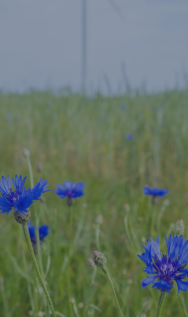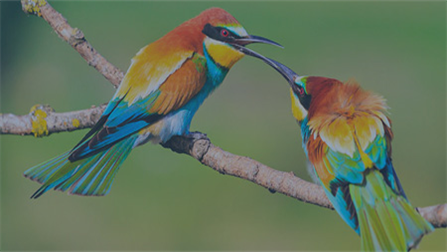OX2: Integrating Biodiversity into Wind and Solar Projects
Start Reading

1. Company at a Glance
This case study explores how OX2, a renewable energy company, has elevated its approach to biodiversity within its broader sustainability framework and business strategy. By welcoming and adhering to science and policy development whilst applying a learning by doing mindset, OX2 aspires to develop solar and wind farms with a net positive impact on biodiversity by 2030.
Renewable energy
Industry
2004
Founded
Sweden
Headquarters
500
Number of Employees
Europe and Australia
Global Presence
2. The Challenge
Society is facing a dual crisis – biodiversity loss and climate change—that requires simultaneous solutions. While the role of renewable energy in phasing out fossil fuels is well understood, the path to reversing biodiversity loss remains far less defined.
At the same time, global expectations are rapidly evolving: companies are now expected to assess and manage their impacts on nature with the same rigor as they do for climate. For a company like OX2, already pursuing climate change mitigation through renewable energy, this shift posed a new strategic challenge: how to ensure that the expansion of renewable energy goes hand in hand with the protection and restoration of biodiversity.
By launching a biodiversity strategy and target in 2021, OX2 formalized its approach to connecting climate and nature action.
3. The Action
Acknowledging the Unknown
To ensure meaningful and effective action, OX2 acknowledges that all relevant impacts might not be known, and therefore aims to learn more about how renewable energy impacts biodiversity, and how biodiversity measures can co-exist with renewable energy development. OX2’s approach to gaining information is to enable and support researchers to study topics relevant to them. Windlife, for example, is a research program conducted by the Natural Resource Institute Finland looking to explore the occurrence and habitat use of terrestrial wildlife in the vicinity of wind farms in Finland. Another example is the Soil Carbon Project, which explores soil management methods to enhance both biodiversity and carbon sequestration in agricultural land in Poland.
Integrating Biodiversity into Incentives and Steering
To drive progress toward its biodiversity target, OX2 has integrated biodiversity-related performance into its employee incentive schemes and loans. In 2024, key performance indicators (KPIs) in employee remuneration focus on two areas: alignment with the EU Taxonomy for sustainable activities—which includes biodiversity criteria—and the implementation of biodiversity actions that go beyond legal requirements, permits or land/sea agreements.
In parallel, OX2 has invested resources in improving data collection and management relating to biodiversity within their systems landscape, enabling improvement and further application of incentive schemes and steering. This entails integrating metrics relevant for biodiversity into several systems including Enterprise Resource Planning and Enterprise Performance Management Systems.
Defining Ox2’s Biodiversity Strategy And Target
In 2019, OX2 launched an internal project to develop a strategy for systematically addressing biodiversity issues. This included identifying priority actions, establishing processes, and setting target levels. The project team, supported by a sponsor from the leadership team, gathered and analyzed data to assess biodiversity-related impacts, risks, and opportunities, using key references such as the Science Based Targets for Nature framework and the Nature Positive Initiative.
External experts supported OX2 in drafting a strategy and defining a target—approved by the CEO IN 2021—to develop nature-positive solar and wind farms by 2030. Since then, the target has been refined to align with new frameworks, standards and emerging best practices. As of 2025, the objective is to develop solar and wind farms that deliver a net positive impact on biodiversity by 2030.
The strategy and target were reaffirmed by the Board of Directors through the approval of OX2’s Sustainability Policy, Environmental Policy, and Annual and Sustainability Reports.
Raising Awareness And Engagement
Since the launch of the biodiversity strategy and target, OX2 has worked to raise awareness around their work on biodiversity. The reasoning is that clarifying the importance and urgency of action enables more engagement on the topic, which is needed for strategy implementation and target achievement. As a result of OX2’s growth, internal training and awareness campaigns are a recurring topic, which is further driven by the developments within the field. The approval of the Kunming-Montreal Agreement and EU’s Nature Restoration Law, for example, were newsworthy events within OX2, and highly relevant for permitting processes in their markets. An internal biodiversity forum—held every five weeks—was created to share experiences and knowledge within the organization which further supported biodiversity action in OX2’s projects. The forum is open to anyone who wishes to join, where participants cover several markets and technologies.
Exploring Measurability And Disclosures
OX2 reports on megawatts that they bring to the market and greenhouse gas emissions arising from fossil energy that solar and wind farms could replace. Measuring biodiversity, however, is not as simple. With a 2030 target in place, OX2 understood early on that they had to figure out how to measure target achievement while simultaneously identifying actions required to achieve desired effects.
OX2’s approach to measuring progress is to use externally developed methodologies that are suitable for solar and wind development in the kinds of nature where they develop projects. To understand what method is most suitable, OX2 has tested several different options in different projects (i.e. ClimB and BOOST), partaking in research projects aiming to develop new methods (i.e. Biobuz) and discussing measurability in biodiversity forums (i.e. MistraBIOPATH and business@biodiversity). So far, OX2 has concluded that there is no method that fits all projects, some markets integrate measurability into permitting processes (i.e. Australia) and some markets leave this as optional.
Alongside measuring indicators of biodiversity in projects, OX2 leans into new standards and frameworks. The company was, for example, one of nine Swedish companies to become an inaugural adopter of the Taskforce on Nature-related Financial Disclosures (TNFD), in their external reporting in 2024.
Contextualizing Action
Effective biodiversity communication requires connecting local actions to global impact. While metrics and data provide quantitative evidence, storytelling serves as a critical complement by creating context and meaning. Stories help audiences understand how individual biodiversity efforts contribute to larger ecosystem restoration and species preservation. Sustainability case studies are on OX2’s website; one of which, for example, describes how restoring natural pastures contributes to upholding a wide range of species within the area.
Another form of communication that OX2 has tested to achieve credibility and transparency around their work with biodiversity is to use communications tools with geographical information (i.e. Project Riberget’s GIS Storymap) to showcase what actions they have done, where and why.
Working Together with Stakeholders
OX2 understands that reversing biodiversity loss is a global challenge that goes beyond the scope of any single company. That’s why, in addition to acting within its own operations, OX2 actively advocates for broader business engagement in nature protection. The company has signed the European Business & Nature Commitment, pledging to assess, commit, transform, and disclose its impacts on nature. It also supports Business for Nature’s Call to Action, encouraging stronger global policies to protect and restore biodiversity.
OX2 also seeks to include stakeholders in their endeavors, since they are paramount for target achievement. This includes land/sea owners who need to approve biodiversity-enhancing actions, local communities who have in-depth knowledge about the area, interest organizations with an interest in safeguarding biodiversity (i.e. fishing and hunting organizations) and future owners of solar and wind farms.
This collaborative spirit is not limited to stakeholders, as OX2 seeks to join forces with other actors so long as they can achieve more together than they both could separately. For example, OX2 has explored large-scale algae cultivation in connection with offshore wind farms enabling both food production and energy generation at sea.
4. Overcoming Barriers
Measurability
The lack of standardization of measurement methodologies makes it challenging to track progress and compare outcomes across projects, markets and peers, as well as evaluating the impact of implemented actions. OX2 has overcome this challenge by testing different measurement methodologies, defining their target scope and measuring actions conducted in their projects as well as quantitative KPIs.
Growth and expansion
The company’s growth to new markets puts additional pressure on OX2 to define and scale their biodiversity strategy and target. Since launching the strategy and target in 2021, OX2 has entered new markets including Italy, Romania and Australia, where ecosystems characteristics and the state of nature can be different. To overcome this challenge, OX2 onboards new markets with its biodiversity learnings and continuously shares experiences across projects and markets.
Cost
Securing financial resources is difficult because the value of biodiversity efforts can be vague, indirect and long-term. To overcome the challenge OX2 is seeking cost-effective biodiversity measures and clarifying how biodiversity is linked to risks and opportunities.
5. Impacts & Results
Biodiversity measures have been implemented across the full mitigation hierarchy (avoid, minimize, restore, compensate) and beyond, creating a strong foundation for replicability across projects.
By participating in research and pilot projects (e.g., BaltVent, Windlife, Soil Carbon Project, BioBuz, and MistraBIOPATH), OX2 contributes to closing knowledge gaps in the sector and tests nature-positive design in real-world conditions, such as structural enhancements in offshore wind farms to support marine biodiversity.
OX2 has identified a set of biodiversity actions applicable to ecosystems commonly involved in its operations—such as forests, agriculture, freshwater and offshore areas—enabling greater consistency and learning across regions.
The company has made its biodiversity strategy public, contributing to peer learning and business engagement through the It’s Now for Nature campaign led by Business for Nature.
Biodiversity reporting is aligned with the European Sustainability Reporting Standards (ESRS E4) and includes key performance indicators to track progress against targets and impact metrics.
6. Key Lessons Learned
Balance measurement and action
Measurement methodologies must be feasible and not divert resources away from on-the-ground implementation.
Progress takes time
Don’t wait for perfection. Even without fully reaching net positive impact, demonstrating steady progress, commitment and real action can inspire others and accelerate change.
Link nature to strategy
Biodiversity action must go beyond values—it needs to be strategically relevant. Connecting biodiversity to corporate goals helps secure long-term support and resources.
Simplify to mobilize
While biodiversity is complex, overcomplicating can stall progress. Reasonable simplification helps unlock and speed up action.
"Tackling climate change and biodiversity loss jointly isn’t a choice—it’s a necessity. At OX2, we have succeeded in elevating biodiversity efforts and are happy to share learnings we have gathered along the way. We continue to work on the topic together with our stakeholders and peers to contribute to global biodiversity ambitions.”
Linda Strindevall, Environment and Climate Change Manager, OX2
7. Resources
Recommended UN Global Compact resources available to support your journey:
Disclaimer: This case example is intended strictly for learning purposes and does not constitute an endorsement of the individual companies by the UN Global Compact.


